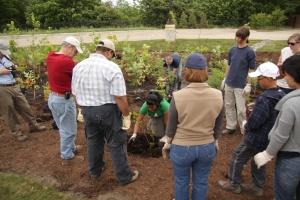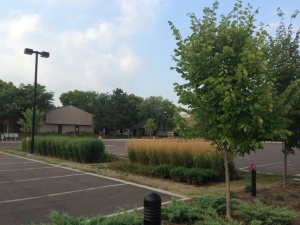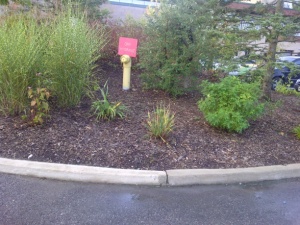Difference between revisions of "Site conditions: public lands"
Kyle menken (talk | contribs) m (Kyle menken moved page Public lands site conditions to Site conditions: public lands: consistency between similar pages) |
Kyle menken (talk | contribs) m |
||
| Line 2: | Line 2: | ||
== Your LID project team == | == Your LID project team == | ||
[[File:Bioretention_People_Standing.jpeg|thumb|Community members who use your municipal facility are a great resource for identifying site needs and providing ongoing volunteer support]] | [[File:Bioretention_People_Standing.jpeg|thumb|Community members who use your municipal facility are a great resource for identifying site needs and providing ongoing volunteer support]] | ||
[[File:Bioretention_Parking_Lot_1.jpeg|thumb|Green features in your parking lot provide shade and evaporative cooling. This plays a role in reducing air temperatures and making the walk from a car to your municipal facility a better experience during hot summer days]] | |||
[[File:Dry_Hydrant.jpeg|thumb|This dry hydrant is connected to a large subsurface cistern. This water supply can be used in emergency situations to fight fires on site. (Source: Aquafor Beech)]] | |||
Whether planning a small- or large-scale LID retrofit project, your project team should include project champions who will promote the retrofit within your municipality and their local community. The project manager should be familiar with the site and its maintenance and operations. The core project team should include a broad range of professionals with different fields of expertise and perspectives to support the project manager. | Whether planning a small- or large-scale LID retrofit project, your project team should include project champions who will promote the retrofit within your municipality and their local community. The project manager should be familiar with the site and its maintenance and operations. The core project team should include a broad range of professionals with different fields of expertise and perspectives to support the project manager. | ||
| Line 27: | Line 29: | ||
===Forming community partnerships=== | ===Forming community partnerships=== | ||
Municipal facilities are hubs for community groups, interest clubs and sports teams. Partnerships with these groups can help promote - and even fund - your LID retrofits. Community groups may have an interest in upgrading or beautifying facilities that they use in common. Volunteer support from these groups may be possible, especially if the project achieves common public goals. | Municipal facilities are hubs for community groups, interest clubs and sports teams. Partnerships with these groups can help promote - and even fund - your LID retrofits. Community groups may have an interest in upgrading or beautifying facilities that they use in common. Volunteer support from these groups may be possible, especially if the project achieves common public goals. | ||
Revision as of 13:42, 9 January 2018
Your LID project team[edit]
Whether planning a small- or large-scale LID retrofit project, your project team should include project champions who will promote the retrofit within your municipality and their local community. The project manager should be familiar with the site and its maintenance and operations. The core project team should include a broad range of professionals with different fields of expertise and perspectives to support the project manager.
The core project team develops an overall plan and provides key information to assist the project manager with decision making. The project team also helps to identify staff, external organizations and stakeholders who can provide information, advice, or professional expertise. For projects that require external support from consultants and contractors, the core team should be able to help with the development of the terms of reference, the tender, or the request for proposal (RFP).They should also review and comment on site design and assist with construction administration and oversight.
Team members must possess a comprehensive understanding of goals and targets associated with stormwater management, site function, and existing operations and maintenance at the site.
Most municipalities are fortunate to have departments that can support the retrofit process. You may consider looking to the following departments for project support:
- Forestry and parks
- Environmental services and stewardship
- Engineering services
- Capital works
- Terrestrial and aquatic services
- Geosciences (hydrology and hydrogeology)
- Marketing and communications
- Community services
The size of your team and the available expertise will depend on the size of your municipality. Small municipalities may not have all the departments listed above. Support from consultants and partnering organizations, such as conservation authorities, can help to get the work done. Operations staff are required team members, since they will be most familiar with existing site maintenance practices. These members will have critical first-hand knowledge of what type(s) of LID practices are best suited given current levels of service and of what changes may be required to accommodate new LID retrofits.
Also consider what support or resources your project may receive from:
- Councilors
- Regional government
- Your local conservation authority
- Provincial staff (MNRF, MOECC)
Forming community partnerships[edit]
Municipal facilities are hubs for community groups, interest clubs and sports teams. Partnerships with these groups can help promote - and even fund - your LID retrofits. Community groups may have an interest in upgrading or beautifying facilities that they use in common. Volunteer support from these groups may be possible, especially if the project achieves common public goals.
Consultation with the public is probably not needed for projects unlikely to affect public use. For example, implementing pollution prevention strategies around maintenance facilities and installing rain barrels on your roof drains are not on the public's radar. However, for small-scale practices to be integrated into public use areas and with the potential to change usage patterns in municipal facilies, public consultation should occur.


